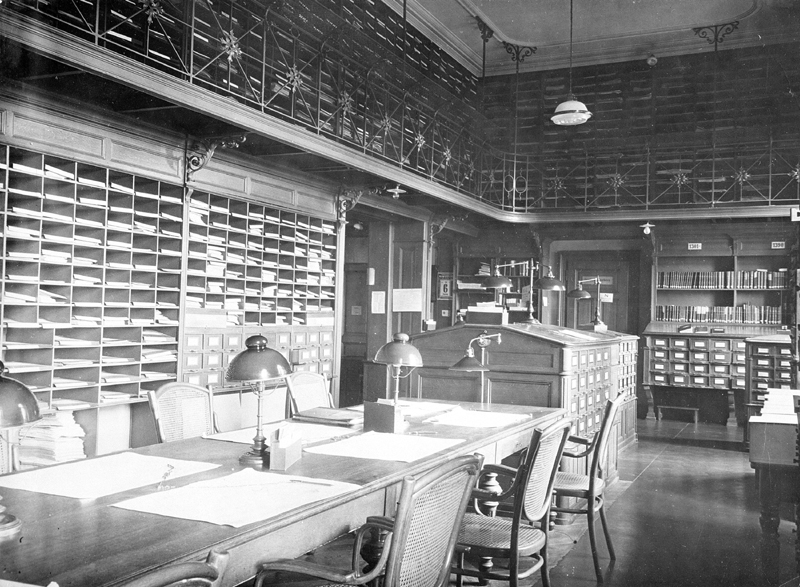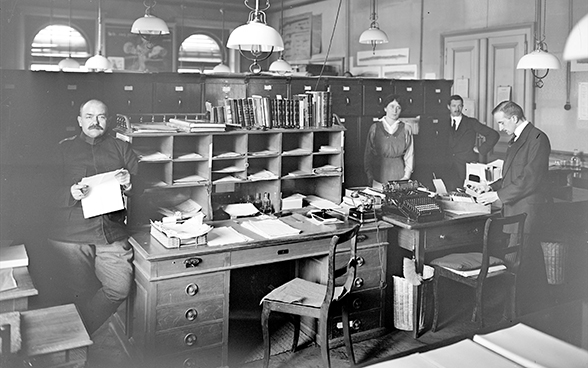Anyone looking for information about the history of the Federal State in the Federal Archives today has more than four million dossiers to choose from. Yet it all started from very small beginnings: when the Helvetic Republic established the Central Archive in 1799, it contained just a few diplomatic documents.
.jpg)
In 1798, the Councillors of the Helvetic Republic (1798–1803) decide to establish a national archive. The Archive of the Helvetic Republic becomes Switzerland’s first central archive. It changes location on a number of occasions, as it is always situated at the headquarters of the Helvetic Republic. The core of the archive consists of treaties and other diplomatic documents. During the Mediation Period (1803–1813), the Restoration (1814–1830) and the Regeneration (1830–1848) it grows steadily. Its home is in Bern city hall. With the foundation of the Federal State, the “Federal Archive” becomes part of the Federal Chancellery. In 1849 Johann Jakob Meyer, Secretary of the Federal Chancellery, becomes the first “federal archivist”.
Archive regulations; the Archive moves to its first dedicated premises
The first detailed regulations on the Federal Archive come into force on 14 September 1864 and apply to documents from 1798 to 1848 as well as “the new Federal Archive” from 6 November 1848. Overall supervision is entrusted to the Federal Department of Home Affairs, and the Archive is headed by an archivist. Archive records are divided into 13 main sections, with each relating to an area of activity, such as “Justice” or “Telegraphy”.
In the second half of the 19th century, the Federal Archive is in what today is the western section of the Swiss Parliament building. The archivist from 1868 onwards is Jakob Kaiser, who joined as a temporary assistant in 1860. His biggest problem is lack of space. Having visited archives abroad, he launches a successful campaign for the Archive to have its own building. The Federal Assembly grants a loan of 67,000 Swiss francs for the purchase of land in the Kirchenfeld district, where little construction has taken place at the time, and for the construction of the building that today houses the Federal Archives.
Academic activities
The new building – initially shared with the National Library – allows the Archive and its staff, which has now grown to four, to establish “exemplary order”, as a sub-committee of the National Council notes with approval. It is needed, because the tasks of the Archive are growing: at the beginning of the 20th century, its main activity is publishing editions of files. In 1914, it receives its first typewriter. The official name “Federal Archives” (“Bundesarchiv”) is bestowed in the same year.
After the First World War, at the behest of the Control Committee of the Council of States, the Federal Archives step up their research into foreign affairs and build up their academic contacts within Switzerland. Research assistant Léon Kern lectures at the University of Lausanne. From 1925, now as a junior archivist, he also serves as Professor of Medieval History at the University of Bern. In 1934, having been promoted to federal archivist, he becomes a member of the council of the General Society of Historical Researchers of Switzerland (AGGS).

Increasing visitor numbers and first rules on closure periods
The 1930s see an increase in the number of visitors to the reading room and written enquiries. The “sport of doctorates”, which Jakob Kaiser bemoaned as early as 1904, appears to be growing year by year. It is obvious that clear guidelines on the use of the Archives are needed. On 9 May 1944, the Federal Council approves the “Regulations on the Communication and Lending of Files of the Federal Archives”. These stipulate that files which “date from at least 50 years ago” are accessible to the public “in general and without restriction”. The number of employees continues to grow after the Second World War in response to rising visitor numbers and new responsibilities. The Federal Archives acquire their first microfilm reader in 1963 and their first copier in 1965.
Towards a Federal Act on Archiving
Increased interest in the Federal Archives manifests itself in the 1960s in the discussion on a proposal put forward by National Councillor Olivier Reverdin. Entitled “Opening up the Federal Archives to academic research”, it criticises the impossibility of conducting an independent investigation into Swiss neutrality in the two world wars because of long closure periods. The complaint finds a receptive audience. Although the new regulations of 15 July 1966 retain the 50-year closure period, for the first time they provide for exceptions to be made in the case of academic research. Seven years later the closure periods are shortened again, to 35 years.
The research activity made possible by these changes is fundamental to the understanding of contemporary Swiss history. During the 1990s, as Switzerland’s role during the Second World War is undergoing a reappraisal, it also creates a new kind of Federal Archives: an institution that, through exhibitions, debates and publications, engages increasingly with the public. At the same time the Federal Archives lend their support to the Federal Act on Archiving of 26 June 1998. This shortens the closure period to 30 years and abolishes preferential access to documents for the academic research community.
At the dawn of the new millennium, the Federal Archives face a new challenge: as they are increasingly called upon to archive digital documents, new concepts and different skills for archivists are required. The shift from paper to digital shapes the modernisation of all the Federal Archives’ services. It also opens up a whole range of new ways for society to make use of archived information.
Last modification 01.11.2016
Contact
Swiss Federal Archives
Archivstrasse 24
3003 Bern
- Tel.
- +41 58 462 89 89
Opening hours reading room
Tu-Th, 9 a.m. to 7 p.m.






